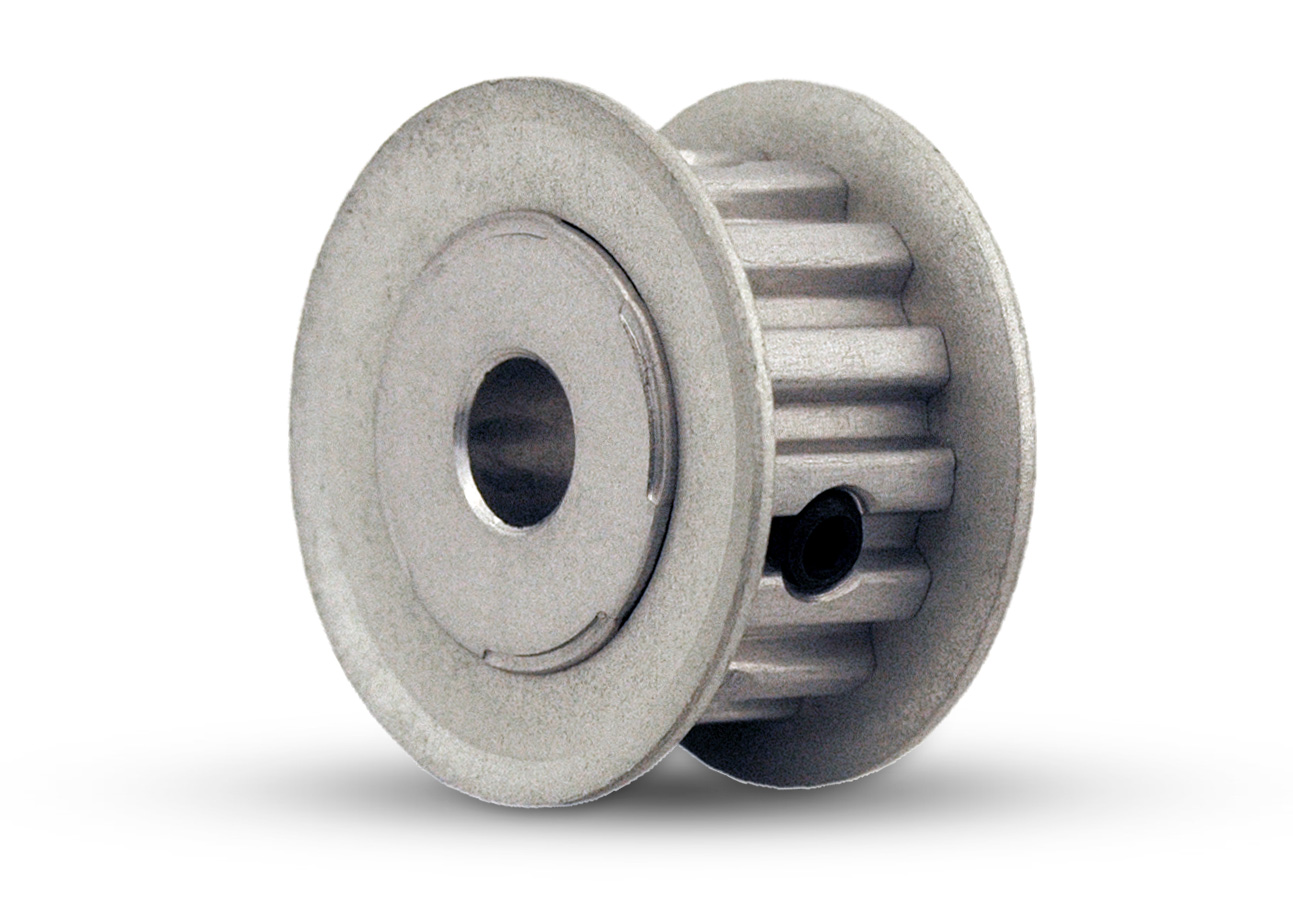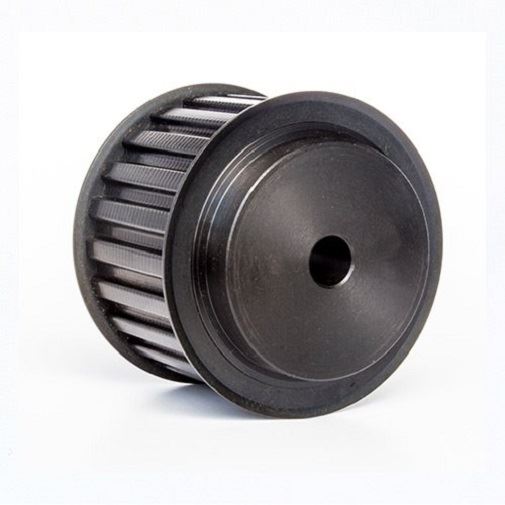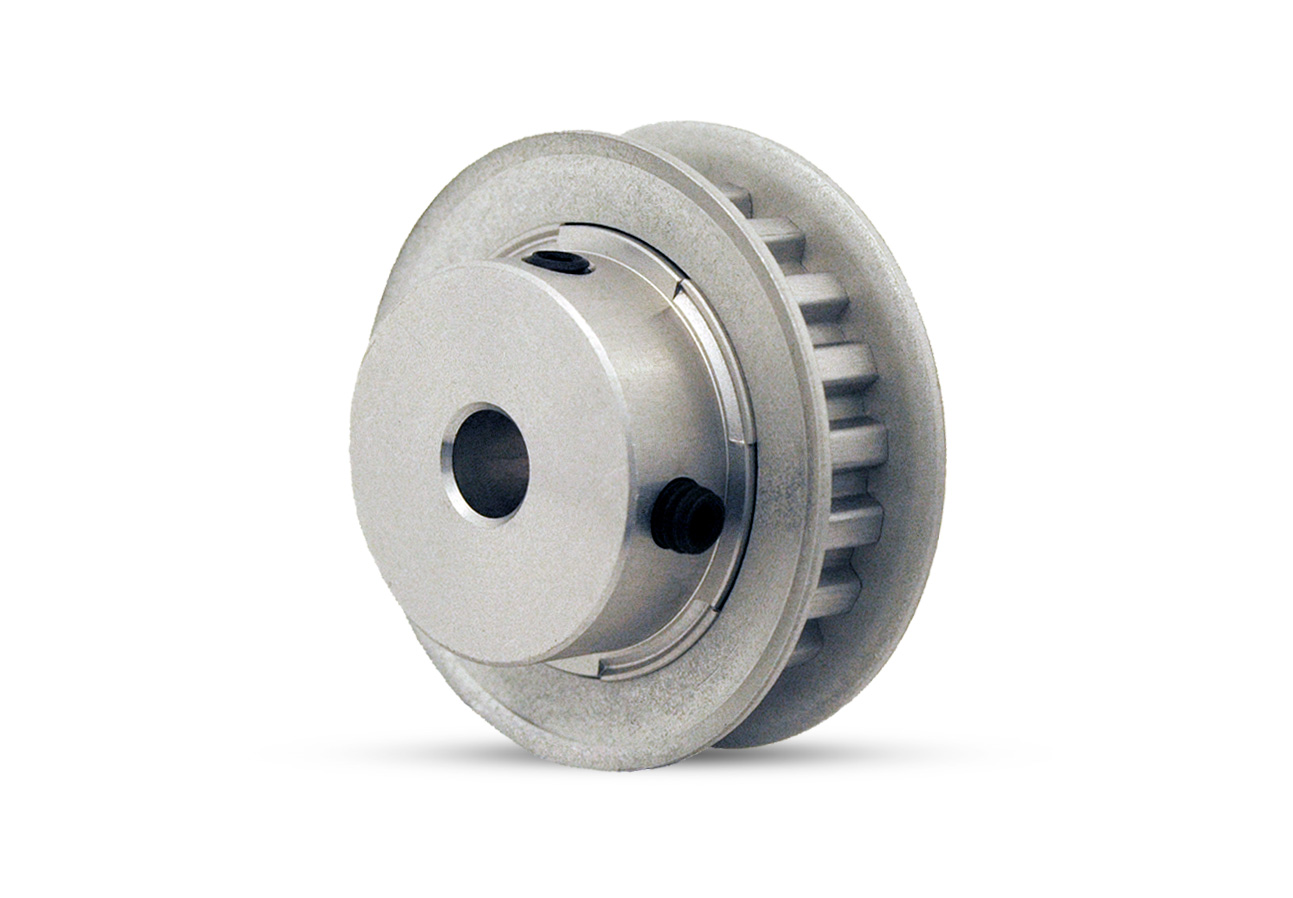Product Description
Product Description
1.Teeth Profile:
|
HTD: |
3M,5M,8M,14M,20M |
|||
|
T&AT: |
T2.5,T5,T10, AT5,AT10,AT20 |
|||
|
STPD: |
S2M,S3M,S4.5M,S5M,S8M,S14M |
|||
|
RPP: |
5M,8M,14M,20M |
|||
|
PGGT (PowerGrip GT): |
2MR,3MR,5MR,8MR,14MR |
|||
2. Materials:
Aluminum timing pulleys
Characteristics:
1.suitable for moderate power transmission
2.light weight / reduced rotational inertia
3.moderate chemical and corrosion resistance
4.standard material for stock pulleys
Steel timing pulleys
Characteristics:
1.suitable for high power transmission
2.durable
3.limited chemical and corrosion resistance
4.aesthetic material
3.Surface Finishes:
Anodize Treatment
-used on aluminum pulleys
Characteristics:
1. Increased chemical and corrosion resistance
2. Available in natural, black, or colored
3. Limited increase of surface hardness
4. Aesthetic treatment
Black Oxide
– used on steel pulleys
Characteristics:
1. Increased chemical and corrosion resistance
2. Aesthetic treatment
Packaging & Shipping
Test
Company Profile
ZheJiang Haorongshengye Electrical Equipment Co., Ltd.
1. Was founded in 2008
2. Our Principle:
“Credibility Supremacy, and Customer First”
3. Our Promise:
“High quality products, and Excellent Service”
4. Our Value:
“Being Honesty, Doing the Best, and Long-lasting Development”
5. Our Aim:
“Develop to be a leader in the power transmission parts industry in the world”
|
6.Our services: |
1).Competitive price |
|||
|
2).High quality products |
||||
|
3).OEM service or can customized according to your drawings |
||||
|
4).Reply your inquiry in 24 hours |
||||
|
5).Professional technical team 24 hours online service |
||||
|
6).Provide sample service |
||||
Main products
Machines
Exbihition
| Manufacturing Process: | Hobbing |
|---|---|
| Material: | Carbon Steel |
| Surface Treatment: | Polishing |
| Application: | Chemical Industry, Grain Transport, Mining Transport, Power Plant |
| Teeth Number: | 8-100t |
| Type for Arc Tooth: | 3m/5m/8m/14m/S3m/S5m/S8m |
| Samples: |
US$ 100/Piece
1 Piece(Min.Order) | |
|---|
| Customization: |
Available
| Customized Request |
|---|

How do XL pulleys contribute to energy conservation and reduced friction in systems?
XL pulleys play a significant role in energy conservation and reducing friction in systems. Here is a detailed explanation of how XL pulleys contribute to these benefits:
1. Efficient Power Transmission:
XL pulleys are designed to transmit power from the driving source, such as an electric motor or engine, to the driven component, such as a conveyor belt or machine. By utilizing toothed belts, also known as timing belts, XL pulleys provide a positive engagement between the belt and pulley, ensuring efficient power transfer without slippage. This efficient power transmission minimizes energy loss, conserving energy in the system.
2. Reduced Friction:
XL pulleys, when used with compatible timing belts, offer low friction power transmission. The teeth on the pulleys mesh with the teeth on the timing belt, creating a positive engagement that reduces slippage and associated friction. The reduced friction between the pulleys and the belt results in improved efficiency, as less energy is wasted as heat and the overall system friction is minimized.
3. Proper Belt Tension:
XL pulleys contribute to energy conservation by facilitating proper belt tensioning. The accurate design and dimensions of the pulleys, combined with tensioning mechanisms, allow for optimal belt tension adjustment. Proper belt tension ensures the right balance between grip and flexibility, minimizing belt slip and energy loss due to excessive tension or slack.
4. Lightweight Design:
XL pulleys are often designed to be lightweight without compromising strength and durability. The use of lightweight materials, such as aluminum alloys or engineered polymers, reduces the rotational inertia of the pulleys. Lower rotational inertia requires less energy to accelerate or decelerate the pulleys, contributing to energy conservation and improved system responsiveness.
5. Smooth Operation:
XL pulleys, when manufactured with precision and high surface quality, enable smooth operation in power transmission systems. The even distribution of forces and reduced friction between the pulleys and timing belt result in reduced vibration, noise, and wear. Smooth operation minimizes energy loss due to mechanical inefficiencies and ensures the system operates at optimal performance levels.
6. System Optimization:
XL pulleys can be selected and designed to optimize system performance in terms of energy conservation and reduced friction. Factors such as the pulley size, tooth profile, and material selection can be tailored to match the specific system requirements. By optimizing the pulley design and characteristics, energy losses and friction can be minimized, leading to improved overall system efficiency.
In summary, XL pulleys contribute to energy conservation and reduced friction in systems through efficient power transmission, reduced friction between pulleys and belts, proper belt tensioning, lightweight design, smooth operation, and system optimization. By utilizing these features, XL pulleys help minimize energy wastage, improve system efficiency, and reduce friction-related wear and tear, ultimately leading to energy savings and increased operational lifespan of the system.

What maintenance practices should be followed to ensure the longevity of XL pulleys?
To ensure the longevity of XL pulleys, it is important to follow proper maintenance practices. Here are some key practices to consider:
1. Regular Inspection:
Perform regular visual inspections of the XL pulleys to check for any signs of wear, damage, or misalignment. Look for worn-out or damaged teeth, cracks, or excessive wear on the pulley surfaces. Inspect the pulleys for proper alignment and ensure that they are securely mounted.
2. Belt Tension:
Maintain the proper tension in the timing belt that is used with the XL pulleys. Incorrect belt tension can cause slippage, premature wear, and reduced power transmission efficiency. Follow the manufacturer’s guidelines or specifications to determine the correct tension for the specific application and adjust it accordingly.
3. Lubrication:
XL pulleys typically do not require lubrication as they are designed for dry operation. However, in some cases, the manufacturer may recommend specific lubrication practices for certain applications. If lubrication is required, use the recommended lubricant and follow the manufacturer’s instructions carefully.
4. Cleaning:
Keep the XL pulleys clean and free from debris, dust, or other contaminants. Regularly clean the pulleys using a soft brush or cloth to remove any build-up that may affect their performance or cause premature wear.
5. Environmental Considerations:
Consider the operating environment of the XL pulleys and take appropriate measures to protect them. In harsh or corrosive environments, use pulleys made from materials that are resistant to corrosion or degradation. Implement protective measures such as covers or enclosures to shield the pulleys from exposure to dirt, moisture, or chemicals.
6. Replacement:
If any signs of significant wear, damage, or deformation are observed during inspections, consider replacing the XL pulleys promptly. Continuing to use worn-out or damaged pulleys can lead to reduced performance, increased risk of failure, and potential damage to other components in the power transmission system.
It is important to consult the manufacturer’s guidelines and recommendations for specific maintenance practices for the XL pulleys used in your application. Following the recommended maintenance practices will help ensure the longevity, reliability, and optimal performance of the XL pulleys in power transmission systems.

What is an XL pulley, and how does it differ from other pulley types?
An XL pulley is a specific type of pulley commonly used in power transmission systems. It belongs to the family of timing belt pulleys, which are designed to work in conjunction with timing belts for precise motion control. Here are the key characteristics and differences of XL pulleys compared to other pulley types:
1. Tooth Profile:
XL pulleys have a tooth profile that is compatible with XL timing belts. The tooth profile is designed to accurately engage with the corresponding teeth on the timing belt, ensuring precise and synchronous motion transfer. The tooth profile of an XL pulley typically has a trapezoidal shape with a specific pitch and tooth height, which differs from other pulley types.
2. Pitch Size:
The pitch size of an XL pulley refers to the distance between adjacent tooth centers. XL pulleys have a pitch size of 0.200 inches (5.08 mm). This pitch size is standardized and ensures compatibility with XL timing belts of the same pitch, allowing for easy interchangeability and system design flexibility.
3. Belt Width Compatibility:
XL pulleys are designed to accommodate XL timing belts of specific widths. The belt width is determined by the application requirements and load considerations. XL pulleys are available in various groove widths to match the corresponding XL timing belt width, ensuring proper belt engagement and power transmission.
4. Material and Construction:
XL pulleys are commonly made from materials such as aluminum, steel, or plastic, depending on the application requirements. The choice of material affects the pulley’s durability, weight, and resistance to wear. The pulleys are typically precision-machined to ensure accurate tooth profiles, smooth operation, and reliable performance.
5. Application Range:
XL pulleys are widely used in applications that require precise motion control, such as robotics, CNC machines, 3D printers, and other automated systems. They are suitable for moderate to high torque requirements and can handle a range of speeds and loads, depending on the specific pulley size, material, and construction.
6. Interchangeability:
One of the advantages of XL pulleys is their interchangeability. Since they adhere to standardized pitch sizes and tooth profiles, XL pulleys from different manufacturers can be used interchangeably with XL timing belts of the same specifications. This interchangeability simplifies replacement, maintenance, and system upgrades.
In summary, an XL pulley is a type of timing belt pulley designed for precise motion control. It differs from other pulley types in terms of its tooth profile, pitch size, belt width compatibility, material and construction, application range, and interchangeability. Understanding these differences is crucial for selecting the appropriate pulley type for specific power transmission requirements.


editor by CX
2023-09-27